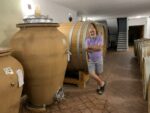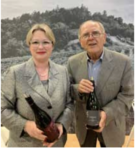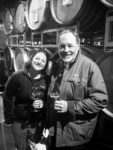Trendy wines with Atlantic character
Interview with Philippe Fezas, the owner and winemaker of Domaine Chiroulet, one of the leading wineries of AOC Côtes
de Gascogne
VertdeVin: Let’s start with introducing the region as it might not be that known to our readers. How would you describe the wines of Côtes de Gascogne in a few words? Philippe Fezas: The wines of Côtes de Gascogne are very aromatic, fruity, and fresh. They represent what the British call crispy, with some Atlantic freshness and vibrancy but at the same time very complex.
VertdeVin: Côtes de Gascogne is a vast region. What are the main terroirs here?
P.F.: Yes, the region extends to three departments: Gers, Lot-et-Garonne et Landes. There are many different terroirs and types of soils: “sables fauves” in the Landes are the reddishorange sands deposited during the middle Miocene, “la boulbène”, acidic silico-clay-limestone soil and in the regions of Tenarèze and HautArmagnac we find limestone and the so-called “terre forte”, a soil rich in heavy clay. The vines of Domaine Chiroulet grow mostly on limestone soils, formed during the Miocene period.
The white wines of Côtes de Gascogne are the most exported French white wines. It is surprising! What are the main markets?
P.F.: For the whole region the leaders’ trio are the UK, Germany, and the Netherlands. For us at Domaine Chiroulet Japan, Belgium and the Netherlands are the most important markets for a long time.
Nowadays climate change is a hot (no pun intended!) topic. What are the most promising grape varieties for Gascogne regarding the changing climatic conditions? What are the growers doing to adapt?
P.F.: I know it does not sound good but climate change is beneficial for the region so far. We have an Atlantic, maritime climate, and originally cool clay-limestone soils. Within 25 years when I started my career, we experienced an increase of 1 degree in temperature, it is a lot. Since 2009, Cabernet Sauvignon is being replanted because it now can achieve better maturity. While Merlot is problematic. It does not like heat and water stress. Maybe Marselan can be an option as it has the same profile as Merlot in terms of sugar, fruit profile, and roundness but having Grenache is a parent, it also shows better resistance to drought. We did our first harvest of Marselan last year and achieved some interesting results. Cabernet Franc is showing well, it stays fresh despite heat waves.
Before we were planting red grapes on the southern slopes and now we change to eastern ones because the sun is softer and there is more wind to cool down the grapes. White grapes are planted on the northern slopes to keep freshness and acidity. We also keep more leaves to protect the grapes. I planted Petit Manseng and it gives amazing results. We already have more than enough sugar but the acidity and aromatic freshness always lag. When we combine both, it is perfect. The clients are looking for freshness now, not alcohol or sugar. I am not too worried, there is a big change but we always adapt.
Is organic or biodynamic viticulture common in the region? What are the challenges?
P.F.: Côtes de Gascogne is very green. We already have a good natural balance, a lot of organic matter, agroforestry, and a lot of HVE. We at Domaine Chiroulet received organic certification for our red wines in 2021. White wines are more difficult. We are protecting them a lot, it is reductive winemaking. With the amount of copper that they use in organic viticulture, it is difficult as copper oxidizes the wine. We want to protect the aromatic compounds, the thiols. We are not trying to avoid or find an excuse not to follow the organic protocol, but we take it seriously and make research. We are also starting working with resistant varieties – floreal, for example, to reduce the number of sprayings.
How does the region react to the recent trends: wines with less alcohol, natural and orange wines, vinification in amphoras?
P.F.: The Gascogne reds are becoming lighter and fresher, more accessible. Merlot and Tannat are used to produce this easy-drinking style. Sparkling wines are getting more and more popular. With limestone soils and a cool climate, it is a natural development. Producers use less Sulphur as the hygiene and technology in the wineries improved a lot.
Sweet and semi-sweet wines are typical for the region. How to protect this category in the “zero sugar” world?
P.F.: We don’t have any problems with selling our sweet wines, this is the category that is growing. Petit Manseng and Gros Manseng, our indigenous varieties, show a good balance between tropical fruits and acidity, they have a nice bitterness that balances well the sugar to the point that it becomes almost unperceivable. Semisweet wines from Gascogne are unique. Our wines have 40-50 gr, so they are very accessible and… delicious!
I can’t help asking you about Armagnac, another signature product of the region. Why should consumers prefer it to cognac or other grape brandies? What are its unique selling points?
P.F.: First of all, the production of Armagnac is much smaller than that of Cognac. It is a craft product created by family domains who are preserving the heritage and the traditions of the region.
Thank you for the interview, Philippe! And cheers to Gascogne! Valeria Tenison
Domaine Chiroulet
32100 Larroque-sur-l’Osse – France www.chiroulet.com




